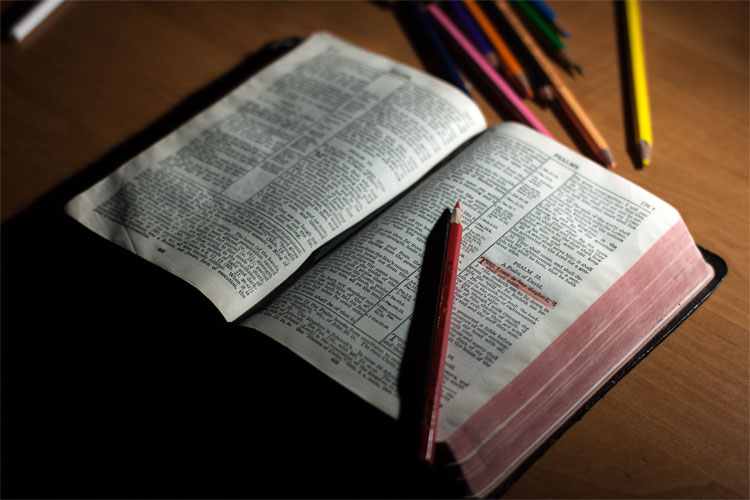The following article on Lectio Divina is based on notes from a presentation given at the Lay Carmelite Convocation, 4 August 2000, by Tom Zeitvogel, T.O.Carm.
Download this page as a PDF download
Definition
Lectio Divina — “The Divine Reading” or “Divine Listening” by hearing the word spoken — is a discipline that intuitively and affectively dwells on a Biblical text as a means of seeking communion with Christ, so as to grow in faith, hope and charity. It is based on “Bible teaching.” For example, in John 15:26, we read: The Paraclete, the Holy Spirit, whom the Father will send in my name will instruct you in everything, and remind you of all that I told you.
The Four Basic Steps of Lectio Divina
Lectio — hearing or reading the Word. Rereading — out loud if possible.
In other words, reading and listening to the Word of God. Not an ordinary reading in matter or manner. Matter — being God’s Word; and Manner — listening or hearing.
Meditatio — pondering and meditating on what was read. Chewing it. Repeating it over and over. Making it relevant to ourselves.
In other words, Lectio is what the text literally says; Meditatio is what the text says to me ... to us. We reflect on the Word, and what it has to say to us in our present context — our present lives. We cannot hide behind past meanings, past tradition. What does it say to us now. Life illumines text; the text illuminates life. Meditatio reveals the meaning the Spirit of God wants to communicate to me.
Oratio — enveloping us in and to prayer. Asking God to help put it into practice.
In other words, when the Word touches the heart, this is the beginning of prayer. All else was preliminary to real prayer. Not intellect or imagination, but prayer of the heart.
Contemplatio — invading our very being. Understanding us and the world in a new way through experiential contact with God. The Holy Spirit prays in you.
In other words, in the first three steps, activity is a dominant factor. In this step, contemplation brings a new and crucial beginning: God doing more and more — closing down our mind and tendency toward devotion. This is not the kind of prayer that we might have been familiar with in the past.
As summarized by Don Marmion, O.S.B
We read (lectio)
under the eye of God (meditatio)
until the heart is touched (oratio)
and leaps to flame (contemplatio)
Duration of Lectio Divina Session
As a rule of thumb, to truly gain from a Lectio Divina what is intended from this form of prayer, the session should be a minimum of 30 minutes. Otherwise it would be best to consider the session more appropriately as simply a period of Scriptural Reflection.
Lectio is not pure reflection nor is it pure contemplation. It is more affective. You listen, are touched, pray, and share (if in a group setting).
One Way to Conduct a Lectio Divina Session with a Group
Before the Group Gathers
- Group Size. If possible, it is well to limit group size to no more than eight individuals — preferably five or six. If necessary, divide the group to meet this criteria. The reason for this suggestion is to insure that everyone in the group can participate.
- Leader. Someone should be designated as the leader. In a group that gathers frequently for faith sharing, it is good to alternate leaders. The leader:
- opens and closes the gathering with a simple prayer. (See “The Actual Process” below for example.)
- chooses an appropriate Scripture passage and asks someone in the group to read it. (When possible, it’s good to let the group members know the passage ahead of time, so that they might be praying with that passage during their personal prayer times.)**
- is attentive to the group as a whole, being sure that each person has the opportunity to share.
- Prior Preparation. If the members of the group know the scripture passage ahead of time, it can be very beneficial for each individual to prepare prayerfully for the “group sharing” part of the session if the participants quietly read the proposed passage ahead of time and ask the Holy Spirit to enlighten them by revealing the ways that passage of Scripture is alive in their own personal life.
The Actual Process
- Leader opens the sharing with a simple prayer. For example: Lord Jesus, You who explained the Scripture to your disciples on the road to Emmaus, be with us now as we listen to Your Word and to one another. Help us to recognize Your presence in our lives, and speak to us through one another. OR pray the: Come, Holy Spirit...
- Reading of the Scripture passage by someone in the group other than the leader. Some possibilities for selecting a passage include the Gospel reading for that particular day, the Gospel reading of the previous Sunday, the Scriptural reference upon which a particular mystery of the Rosary is based, a passage that the leader chooses because of a special need or desire of the group, etc.
- Pause for silent reflection for at least five minutes. During this time it is good to try to adopt the attitude of Our Blessed Mother who “treasured” all the mysteries that were happening in her life and who “reflected on them in her heart.” For example, what does the passage say to you? How is that mystery of Jesus’ life alive in your own life?
- Leader requests initial reaction from each member of the group. This should be only a word or simple phrase on the initial thought that the Holy Spirit has inspired the person to share about the passage. If a participant chooses to not take part in this sharing, then he/she should simply say “amen” and defer to the next person in the group.
- Re-reading of the Scripture passage. This should be done slowly and meditatively. It is suggested that a different member of the group read the passage this second time.
- Pause again for silent reflection for at least five minutes...once more trying to adopt the attitude of Our Blessed Mother in savoring this Scriptural event.
- Allow each person the opportunity to share their responses to the reading. Request each person to share their thoughts in a bit more detail. Listen to one another attentively. Often God speaks to us through the reflections of another person. If one does not wish to take part in this sharing, then simply say “amen” and defer to the next person in the group.
- Final reading of the Scripture passage. Once again the scripture passage is read slowly and meditatively by another member of the group. The leader invites all to sit in silence for about 5-10 minutes to let the passage “sink in”.
- The leader closes with a prayer of gratitude for God’s presence in the lives of all gathered there together, and the group concludes with the Our Father. As an alternative, each person can be invited to express their own prayer of gratitude or petition, and then the Our Father is prayed together.
Key Points to Remember
- Listen to one another. Try to avoid the very common pitfall of preparing what you want to say when another is talking. The Holy Spirit will give you words when it is time.
- Don’t debate or discuss another’s insights. Just listen to the thoughts of their hearts.
- Try not to compare another’s insights or experiences with your own. God is working in the lives of each of us in splendid and varied ways. Don’t allow yourself to fall into the trap of feeling that your experiences or insights are inferior to those of others.
- Be creative. Alter the above process in any way you like while keeping the essentials. For example, you may want to begin by reciting together one decade of the Rosary, and then spend some time in quiet and spoken reflection on the meaning of that mystery in your life.
- Spend enough time. Strive to spend a minimum of 30 minutes for this to be considered truly a period of “Lectio Divina”, otherwise it would perhaps be more appropriate to consider this time, although laudable and commendable, a period of Scriptural reflection only.
Lectio Divina and Carmelite Spirituality
St. John of the Cross, in Maxims on Love #79† says “Seek in reading and you will find in meditation; knock in prayer and it will be opened to you in contemplation.” This maxim shows his knowledge of the four elements of Lectio Divina.
The above is actually a paraphrase by John of Luke 11:9: “Seek and you shall find; knock and it shall be opened to you.”
Contemplation. A love too deep for words. It is complementary to the action of busy people. These notions are not mutually exclusive. They are compatible with Christian activity in the world.
Self-surrender. Not a giving up, but a “delivering up” of oneself to love. We are not in control; God is in control. This is “God-centered,” not “selfcentered.” It is also not a false self. False self has many faces: overbearing, tearful or demanding, clown, daredevil, free spirit, conventional, unconventional, hermit, judging others, telling others what to do. But in self-surrender, God is in control.
In Summary:
1. Reading seeks;
2. Meditation finds;
3. Prayer desires, and demands; and
4. Contemplation tastes and experiences with delight.












